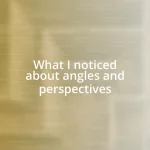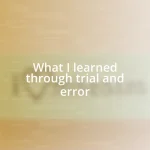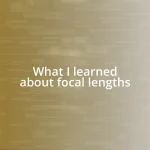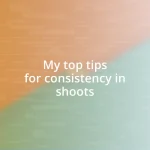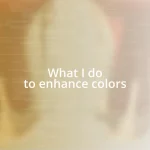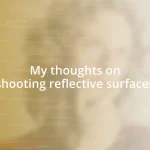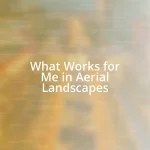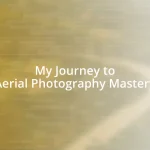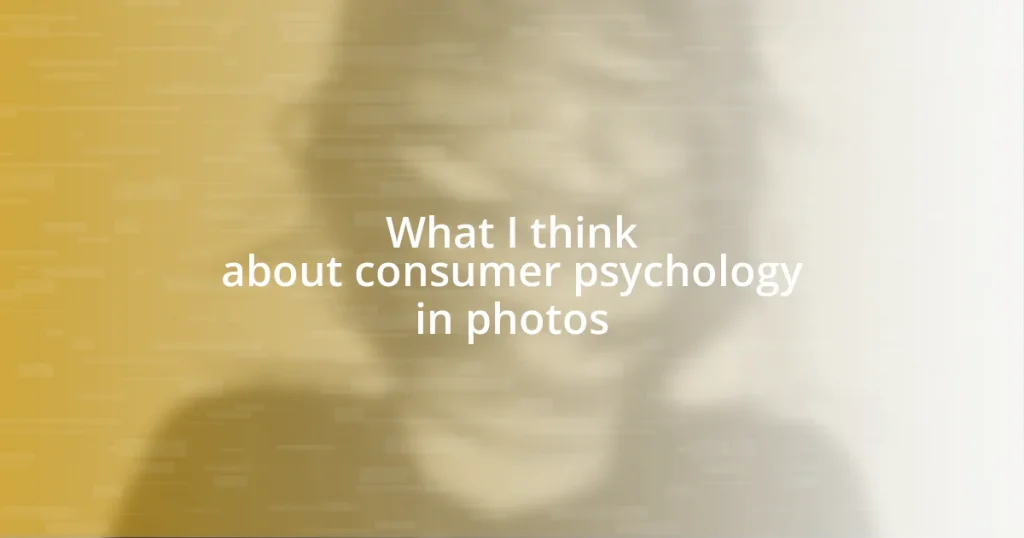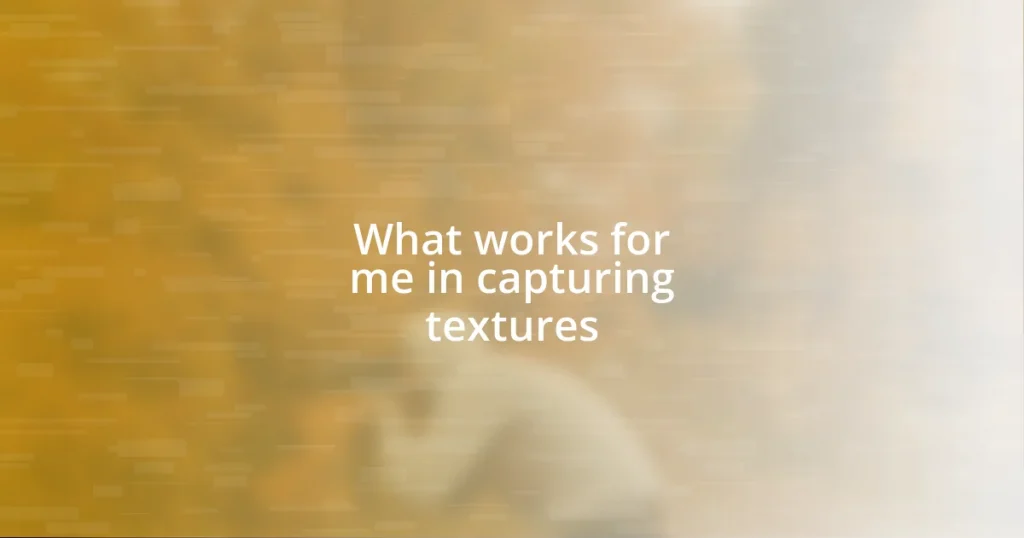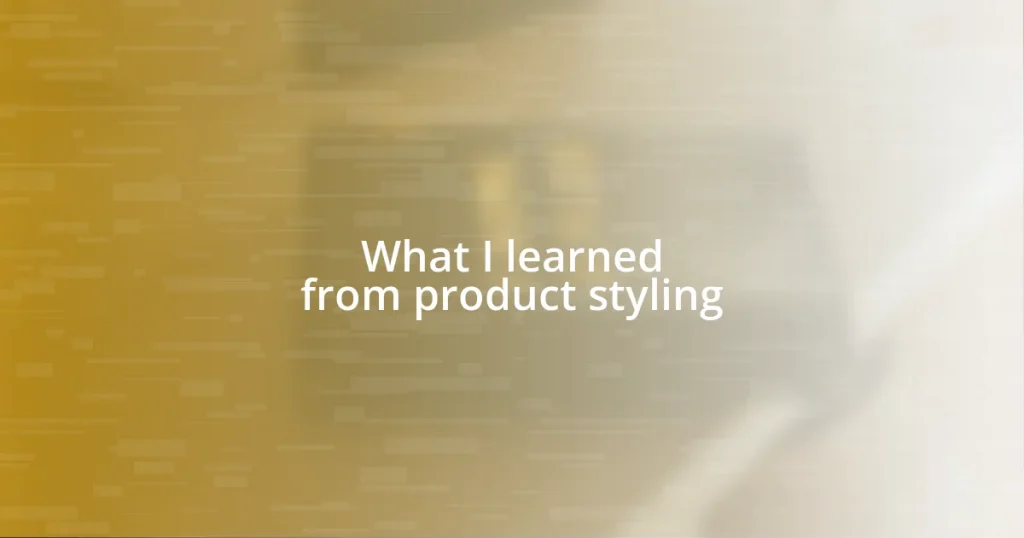Key takeaways:
- Aerial wildlife photography requires both technical skills and a deep connection with nature, enabling photographers to capture intimate moments with animals in their habitats.
- Choosing the right equipment, particularly drones with high-resolution cameras and good battery life, significantly enhances the quality of wildlife images.
- Post-processing is essential for bringing images to life, including adjustments in color, cropping for emphasis, and sharpening details to enhance the visual storytelling of wildlife photography.

Understanding Aerial Wildlife Photography
Aerial wildlife photography opens up a fascinating perspective on the natural world. I remember the first time I lifted my drone into the sky, watching as the landscape unfolded beneath me like a vast canvas. It was a rush to realize that I could capture animals in their habitats from angles I’d never dreamed of before. This experience made me appreciate the intricate dance of nature, and I found myself wondering: how many stories unfold just out of our sight?
Understanding this niche form of photography involves more than just technical skills; it’s about connecting with the wildlife you’re capturing. I’ve encountered moments where I felt like a silent observer, witnessing the delicate interactions among animals. Whether I was tracking a herd of elephants from above or watching a hawk soar gracefully, these experiences brought me closer to the essence of nature. Have you ever experienced the thrill of capturing a perfect shot while feeling completely in tune with your surroundings?
The equipment you choose plays a crucial role in aerial wildlife photography. Drones equipped with high-resolution cameras can often make or break your shot, and I’ve learned the hard way how important it is to have the right tools. Early on, I struggled with inconsistent quality in my images, but after investing in a reliable drone, everything changed. Suddenly, each image felt more vibrant, more alive, capturing the true beauty of wildlife in a way I hadn’t thought possible. What equipment choices have transformed your photography journey?

Choosing the Right Equipment
Choosing the right equipment for aerial wildlife photography can significantly impact the quality of your images. From my experience, investing in a high-quality drone is essential. The first time I upgraded to a drone with optical zoom capabilities, I was amazed at the clarity of distant subjects. I could capture majestic eagles perched on high cliffs without disturbing them, adding a new layer of intimacy to my work. Have you ever realized that the right tool can open up a world of creative possibilities?
Camera specs matter too; I always look for drones with a camera that has at least a 4K resolution. Initially, I underestimated the importance of this detail. After capturing my first few images in lower resolution, I felt disappointed when I realized the potential was just out of reach. Once I transitioned to a drone that offered 4K, my wildlife shots transformed, each one bursting with vibrant colors and details that truly showcased the animal’s natural beauty. Have you felt that thrill of a crisp image highlighting the delicate features of an animal?
Lastly, I can’t stress enough the importance of battery life when choosing your equipment. While on a trip to photograph migratory birds, I once ran out of battery mid-session, missing a stunning flight display. Since then, I always carry extra batteries—it’s a simple but effective way to ensure I’m ready for unexpected moments. I’ve learned that preparation can often make the difference between a fleeting memory and a stunning photograph.
| Equipment | Key Features |
|---|---|
| Drone | High-resolution camera, stability, optical zoom |
| Camera | 4K resolution, good low-light performance |
| Accessories | Extra batteries, memory cards, ND filters |

Mastering Camera Settings
Mastering camera settings is essential for capturing breathtaking aerial wildlife photographs. I’ve found that adjusting the aperture and shutter speed can transform a mediocre shot into something extraordinary. When I first started, I often left my settings on automatic, only to be disappointed by blurry images of fast-moving animals. But the moment I grasped how to manually adjust these settings, it felt like flipping a switch—I could finally seize the essence of dynamic moments, like a gazelle leaping gracefully across an open plane.
Here are some key settings to focus on:
- Aperture (f-stop): A lower f-stop (e.g., f/2.8) allows more light, perfect for low-light situations. It gives a beautiful depth of field, isolating your subject against a slightly blurred background.
- Shutter Speed: Quick shutter speeds (1/1000 sec or faster) are crucial when photographing moving wildlife, ensuring sharp images of creatures in action.
- ISO: Keep your ISO as low as possible (e.g., 100-400) to minimize noise, but raise it as needed in low-light conditions to maintain clarity.
- White Balance: Customizing your white balance based on the lighting conditions can enhance color accuracy, making those sunsets or animal fur look just right.
As I experimented with these settings, I began to notice how they affected the mood of my shots. There was a day when I hovered above the wetlands, adjusting my settings for a family of swans gliding across the water at dusk. By fine-tuning my shutter speed and ISO, I managed to capture that breathtaking moment when the golden light kissed the surface of the water, producing an image that took my breath away. It’s that feeling of connection, of perfect timing, that keeps me eager to refine my skills. Have you ever felt that exhilarating rush from capturing a moment that truly tells a story?

Planning Your Aerial Shots
Planning your aerial shots can significantly elevate the quality of your wildlife photography. Before I head out, I often map out my shooting locations based on animal behavior, weather conditions, and most importantly, lighting. I vividly remember a time when I anticipated a sunset shoot over the forest. I arrived early to scout the area and carefully positioned my drone, ensuring that the light would perfectly illuminate a deer crossing a meadow. The result? A stunning silhouette bathed in golden light that still hangs proudly on my wall.
But it’s not just about location; timing is everything. I always check wildlife migration patterns and seasonal behaviors. On one memorable trip to photograph arctic foxes, I learned that their activity peaked during dusk. Armed with this knowledge, I planned my flight schedule to align with this time, capturing the irresistible playfulness of the kits in the soft, late evening light. Have you considered how important it is to synchronize your shooting times with the animals’ natural habits?
Another aspect I emphasize is flexibility. Mother Nature is unpredictable, and I’ve had my share of unexpected weather changes. Once, while preparing for a shoot on a bright sunny day, a sudden storm rolled in. Instead of packing up, I found a nearby sheltered spot and elevated my drone to capture the swirling clouds. The dramatic contrast of the angry sky against a grazing elk created an image that resonated powerfully with viewers. In the world of wildlife photography, being prepared to adapt can often lead to those unexpected, breathtaking moments that make your portfolio shine. Have you ever captured a stunning photograph simply because you were willing to embrace the unplanned?

Techniques for Capturing Wildlife
There’s nothing like the thrill of utilizing composition techniques to enhance wildlife photography from above. When I hover my drone over a stunning landscape, I often think about the rule of thirds—placing the subject off-center to create more dynamic photos. I once spotted a pack of wolves roaming in a snowy expanse; by positioning them in the left third of the frame with the vast white wilderness stretching out behind them, I transformed a simple image into a captivating narrative. Have you ever recognized how a slight adjustment in composition can turn an ordinary shot into a breathtaking artwork?
Another technique that I find essential is capturing the action through framing. I love the excitement of anticipating an animal’s movement, especially during a hunt or a play session. I remember filming a family of otters playing on a riverbank. Before they dove back into the water, I instinctively framed the shot to include the rippling reflections in the water around them, enhancing the dynamic energy of the scene. It’s that balance of patience and precision that pays off, isn’t it?
Additionally, I often harness natural light to its fullest potential. I recall a magical encounter with a soaring eagle, its wings catching the golden morning sun. By waiting for that perfect moment when the bird glided into my line of sight, I instantly knew I could highlight its majestic form against the contrasting blue sky. This experience taught me that timing and the sun’s angle can make a world of difference—how do you decide when to press the shutter for a wildlife moment that will leave viewers speechless?

Post-Processing Your Aerial Photos
Post-processing is where the magic truly happens for aerial photos. After a shoot, I dive into software, eager to enhance the colors and details that may have been slightly muted during capture. For instance, I once had a series of shots showcasing flamingos taking flight during sunrise. With a few adjustments to contrast and saturation, those images transformed into vibrant scenes that practically jumped off the screen. It’s fascinating how software can breathe new life into your photography, isn’t it?
In my experience, cropping plays a significant role in emphasizing the subject and composition. I remember editing a drone shot of a herd of elephants. By subtly adjusting the frame and removing distractions, the power of those gentle giants became the focal point of my image. This process made me realize how a simple crop can alter the viewer’s perspective, making the moment feel much more intimate. Have you experimented with cropping to tell a more compelling story?
Additionally, applying a bit of sharpening is crucial when it comes to aerial images. I’ve had instances where the final photo lacked the crispness I envisioned. Using selective sharpening helped highlight intricate details, like the texture of feathers in a hawk soaring above. This not only enhances the viewer’s experience but also emphasizes the raw beauty of wildlife. Isn’t it rewarding when you see an image come to life through meticulous editing?

Sharing and Showcasing Your Work
Sharing your wildlife photography isn’t just about showcasing your images—it’s about telling a story. When I post my aerial shots on social media, I ensure each image gets a thoughtful caption, inviting viewers into the experience behind the capture. I once shared a picture of a lone wolf pacing along a ridge at sunset. The rhythmic elegance of its movements stirred something deep within me, and I wanted my followers to feel that same connection. How do you convey the emotion behind your pictures when sharing them with the world?
Engagement is key when showcasing your work, so I often interact with my audience whenever I post. I’ve learned that inviting questions or thoughts about my experiences enriches the exchange. For instance, after a post featuring sea turtles gliding beneath the surface, I posed the question: “What emotions do you feel when witnessing such serenity in nature?” The responses sparked a fascinating dialogue, turning a simple photo into a shared moment of reflection. How can you foster community through your wildlife photography?
In addition to social media, I also explore opportunities for exhibitions or local galleries. The excitement of seeing my work displayed publicly enhances my connection to the art form. I once participated in a community showcase, where one of my drone images of a busy beehive captured the attention of an environmentalist. That moment reminded me of the profound impact visual storytelling can have—it inspired conversations about conservation. Have you considered how sharing your photography can create awareness and ignite passion for wildlife preservation?



